Hello nonprofit digital marketers! We hope you’ve had a wonderful time so far digging into this year’s Benchmarks results — and we wanted to bring you a closer look on our (well… at least my) favorite section: ads.
(No seriously, the whole study is great and I hope you’ve spent loads of time with all of it! I am just personally biased because I think ads are interesting and fun.)
This is going to be a long post, but here are the highlights:
- Nonprofits are spending more than ever on ads, and most (though not all!) is going to fundraising.
- There are very good reasons to run non-fundraising ads, especially for small organizations.
- Within fundraising ads, we’re in a period of great transition and volatility.
- Social remains, frankly, a hot mess.
You ready? Let’s get into it.
Nonprofits are spending more than ever on ads, and most (though not all!) is going to fundraising.
From 2023 to 2024, nonprofit ad budgets grew by 11% — a steady clip, and well outpacing inflation.

We’ve seen some version of this every year that I’ve worked on the study, and I think it’s for a simple reason: ads work.
This is a challenging fundraising environment for a lot of organizations: overall revenue grew modestly (2% year-to-year), but with wide variation (including some sectors that saw flat or even negative revenue growth). It was just hard to raise money in 2024! Knowing that, it makes all the sense in the world that organizations would look to ads — and specifically direct fundraising. Done successfully, fundraising ads can feel like a machine that prints money, and they accounted for 72% of media spend last year.
(We’ll chat more in a minute about the other advertising goals, namely awareness and lead gen — get ready, because there’s a good case to be made that even those campaigns are indirectly fundraising-oriented!)
Year-over-year growth is interesting, but it’s actually not my favorite way to talk about ads budget: my favorite is the comparison of ads budget to online revenue. This metric asks, for every dollar nonprofits raised online, how much did they reinvest in ads? Overall, that answer was $0.14 — so an organization that raised $1MM online would expect an annual ads budget of $140k.
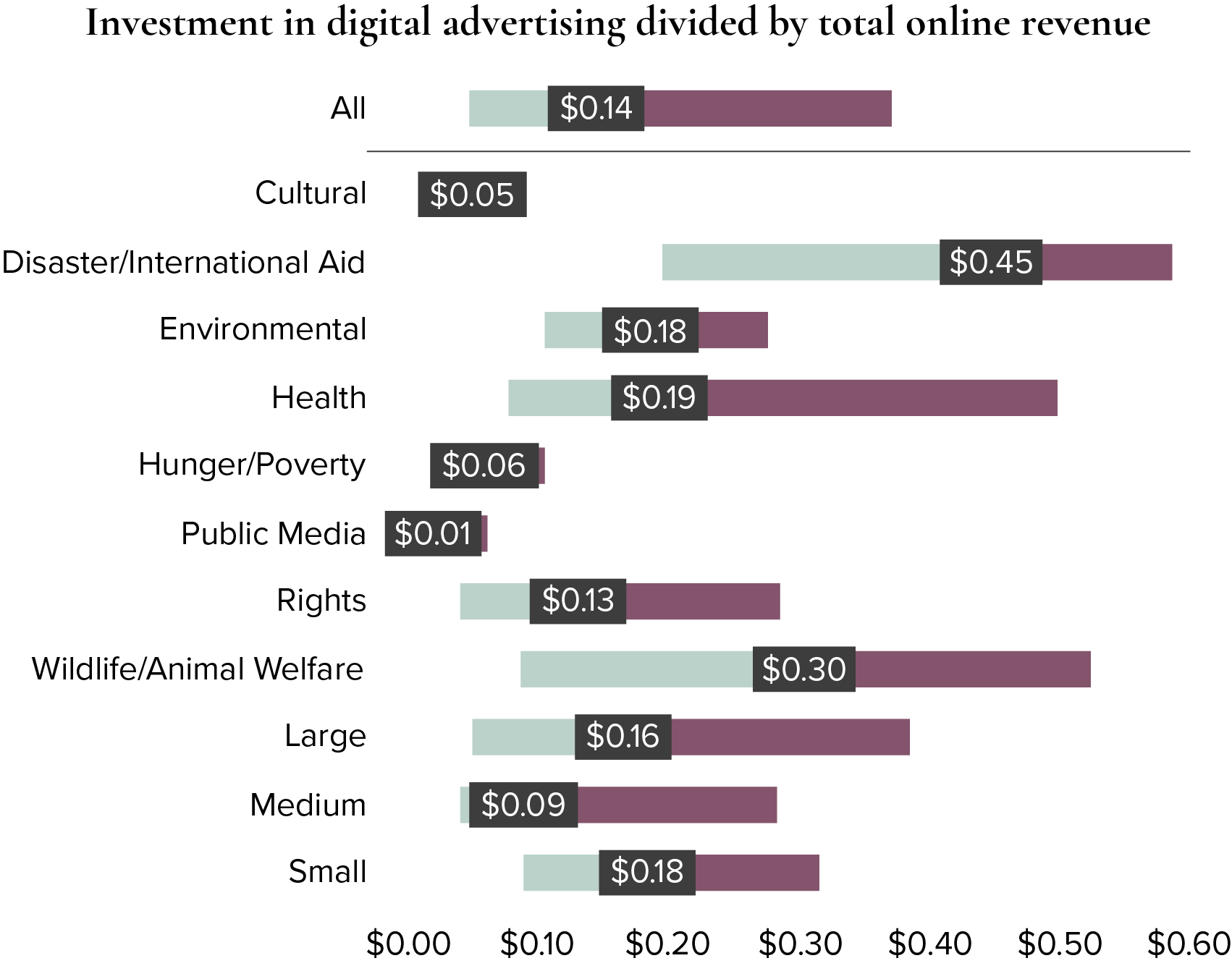
I love this metric, I think it is a super-smart way of gut-checking the size of your ads budgets. It’s especially interesting when broken out by sector: for example, it tells us that disaster/international aid organizations are incredibly aggressive in funding their ads programs. (Incidentally, that might explain why that sector had the lowest budget increase year-to-year, at 1%: if you’re putting nearly half your revenue back into ads, you’ve got less room to grow.)
Okay, so where’s all that money going? Like I said, most of it is going to fundraising (72%), with the rest primarily going to awareness and lead gen. Here’s the interesting part: that breakout varies hugely by size.
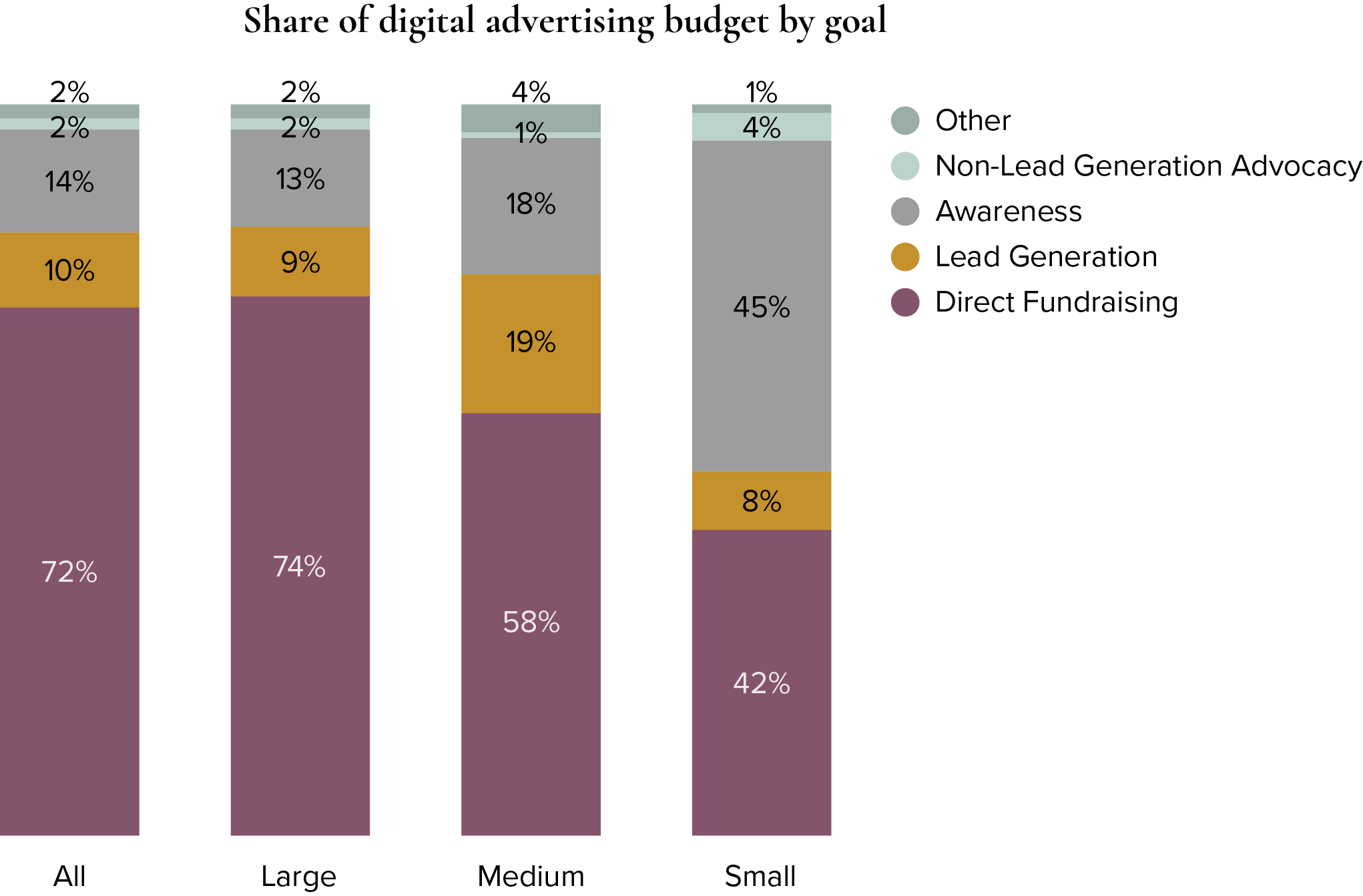
Check out the difference between small and large organizations: while large groups are putting ¾ of their budgets to fundraising, small groups are devoting nearly half to brand awareness — outpacing even direct fundraising! What’s going on there?
There are very good reasons to run non-fundraising ads, especially for small organizations.
There is a simple answer to this question, and as you would expect it involves the Popeyes pickle menu.
When you (hypothetically) sit down in your living room on a Saturday afternoon to watch a much-anticipated WNBA matchup between Angel Reese for the Chicago Sky and Caitlin Clark for the Indiana Fever (I hear there is also some men’s basketball happening right now, but not in my house 😇), you are probably not actively in the market for a chicken sandwich. Nonetheless, Popeyes will show you ad after ad after ad for their pickle menu. The ads may not even say, whip out your phone right now and order the pickle menu! They just say, hey, did you know we currently have a promotional pickle menu?
Popeye’s knows you may not need a sandwich now, on Saturday afternoon watching a basketball game, and that’s okay. Because Popeye’s also knows that there will be a night (again, hypothetically) where it’s 10pm and you’re driving home from rugby practice and you’re ravenously hungry and you’re hit with a wave of despair as you realize that your fridge is full of raw ingredients but no actual cooked food — and that will (still, hypothetically) be the moment where you look up and lock eyes with the neon splendor of an open Popeye’s drivethru. And when you find yourself (literally so hypothetically), sitting in your car at 10pm Thursday night, tearing into that (purely hypothetical) pickle-glazed sandwich with vigor and gusto, Popeye’s knows it will be because of ads — ads which you may not even consciously remember! — served to you a week earlier.
I’m joking, but seriously, that is the point of awareness advertising: not necessarily to create intent, but to ensure you capture intent when it happens (often completely organically).
One of these days, your supporters will get a push notification about some horrible thing happening in the world, and they’ll go searching for a way to help. In that moment, the difference between giving to you and giving to one of your peers will in many ways come down to brand awareness. Do they remember your name? Are they familiar with your work? Are they confident you’ll use their money wisely and effectively? All of that is brand awareness.
If you’re one of the big dogs (and you know who you are!), you don’t need to invest as much paid media in introducing yourself: you can focus on turning attention into dollars. (It’s also possible that you’ve worked your way into that sweet spot of earned media — an extra boost!) But if you’re a small organization, there’s a real possibility that limited brand recognition poses a serious barrier to direct fundraising: that’s what I think these results are reflecting.
Within fundraising ads, we’re in a period of great transition and volatility.
With that understanding that most-but-not-all ads spend goes to direct fundraising, let’s talk about the details. In Benchmarks, we break out fundraising ads by channel: that includes some channels that just about everyone will recognize (search, social, display), and a few that might feel unfamiliar.
Those less-familiar channels were a huge standout this year: multichannel formats, connected TV, and peer-to-peer SMS all grew massively in terms of overall investment. Really, look at them — they practically jump off the page:
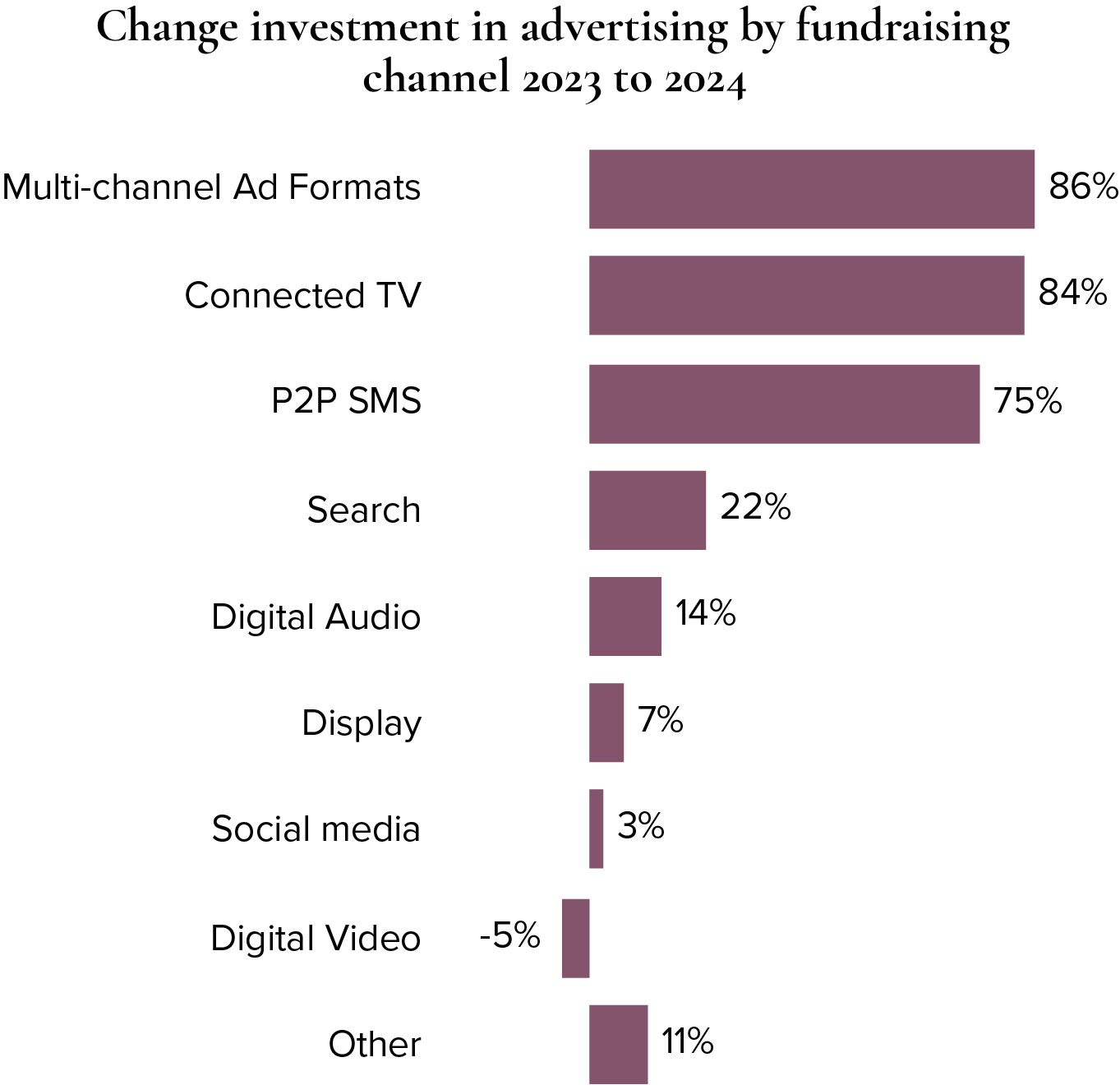
Let’s look at each one in turn.
In an ads context, peer-to-peer SMS is slightly different from the P2P SMS we discuss elsewhere in Benchmarks (under Mobile Messaging) — and the difference is list ownership. Rather than having staff, volunteers, or contractors text your list, these vendors are texting their owned lists (often built via the voter file or purchases from political campaigns), and charging a fixed per-donation cost. This was a pretty big year for mobile generally (with nonprofit lists +5% and message volume +31%), and it’s interesting to see that growth showing up for ads too.
Connected TV (as a reminder) is TV inventory bought programmatically, AKA the same way you likely buy display and video ads. Just as display ads have shifted from a website takeover model to impressions bought algorithmically in real-time on a variety of sites, CTV represents a shift away from buying spots from a cable network (and toward that same algorithmic real-time bidding).
CTV is great because it enables you to buy TV inventory at lower minimums with more precise targeting — you don’t need to buy out the entirety of TV inventory for this one WNBA game, you can just say “I want to target Chicagoans in their early 30s who love pickle-based foods.” That level of flexibility and precision is ideal for nonprofits, and it’s been really exciting to see this (otherwise prohibitively expensive) channel become more accessible to our part of the industry.
“Multi-channel ads formats” is a bit of a mouthful, but what you need to know is this: it’s mostly Google’s Performance Max (PMAX). (We assume there’s some Meta Advantage+ mixed in, along with some other vendors — but Google’s the big one.)
PMAX relies heavily on AI to deliver ads in whatever context and format it thinks is likeliest to convert: essentially, you give it a set of baseline assets (video, copy, images, a logo), and it will turn them into a dizzying array of ads across all Google products (search, YouTube, display, Gmail and others). It includes search, but it’s not limited to search… which is important because search is very unstable right now.
Yes my friends, this is the part of the blog post where we panic about search ads!
As long as I’ve been in this industry, search ads have been the foundation of every nonprofit digital ads program. There is no one on earth more valuable than the person googling “donate to [your brand name],” and there is almost no limit to how much you’ll spend to deliver a search ad to them. Search ads had the highest ROAS of any channel in Benchmarks ($2.23), and they’re consistently the first fed when nonprofits are splitting their fundraising budgets by channel.
Nonetheless, traditional search is fading — five years from now, it will be radically different if not entirely gone. A year ago, we called Google’s introduction of AI overviews a “potentially seismic shift” in the shape of the open internet: today, I would cut out “potentially.” Industry experts expect search traffic to decline sharply in the coming years, with AI leading to more zero-click searches and thus fewer web visits. (Anecdotally, we’re already seeing this for many nonprofits.)
Google, the search giant, is in a precarious position: while they just announced plans for ads in AI results (smart and long overdue!), they’ve lost two major antitrust cases and are facing potentially massive changes to their structure and products. (We wrote about it recently: tl;dr we think this is a good thing!)
All of that’s to say… nonprofits should prepare for a world where their ads programs are much less reliant on search ads. Experimenting with Performance Max is a good start, layering in additional channels like P2P SMS and CTV (along with audio, display, and video) is even better.
Okay, so AI is threatening massive disruption to many parts of the digital landscape — good thing the rest of the internet’s in good shape, right? Haha, jokes!
🙃 It’s time to talk about everyone’s favorite tire fire: social.
Social remains, frankly, a hot mess.
My colleague Dustin recently wrote about the steps nonprofits can take to reclaim their audiences from the (extremely evil) social media billionaires — that topic’s been very top of mind over here! Elsewhere in Benchmarks, we found that 75% of organizations have begun building a presence on one of the emerging social media platforms (such as Threads or Bluesky), while nearly half of nonprofits are already on TikTok. It’s clear that there’s broad discontent with the big social networks, even as organizations find it hard to walk away — and that’s exactly what we see for ads too.
Within fundraising, spend on social media ads rose 3% year-to-year: right on track with inflation, no more no less. When you peek under the hood, it’s clear that organizations are maintaining essentially flat investments on Meta, and experimenting pretty aggressively with TikTok as an alternative:
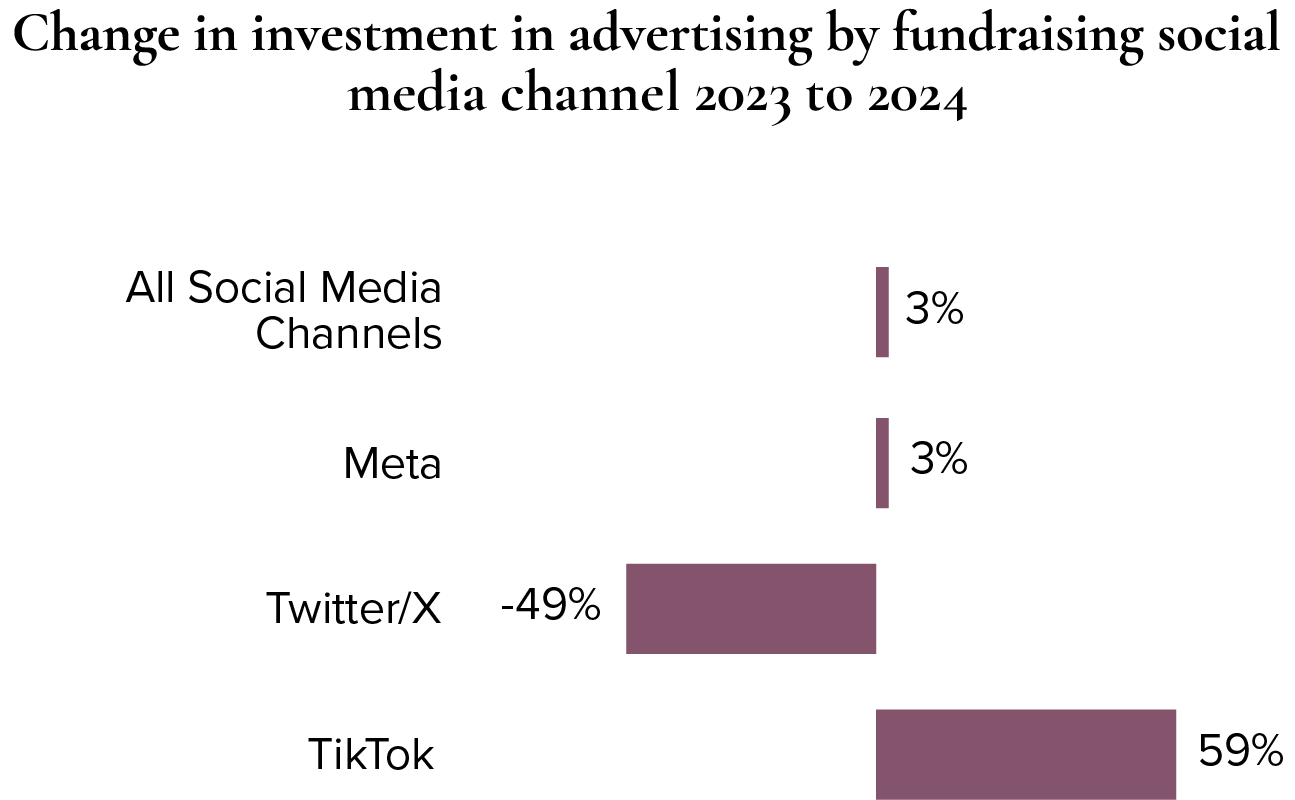
I find this to be so interesting because TikTok for fundraising is pretty bad: at $0.03, the ROAS truly couldn’t get worse. To me, that suggests a pretty high degree of desperation: organizations are so fed up with Meta that they’ll tolerate astonishingly poor returns on platform testing in hope of finding an alternative.
We see something similar for lead generation: nonprofits are testing TikTok and YouTube, even though costs on those platforms can be 4-5x higher than Meta.
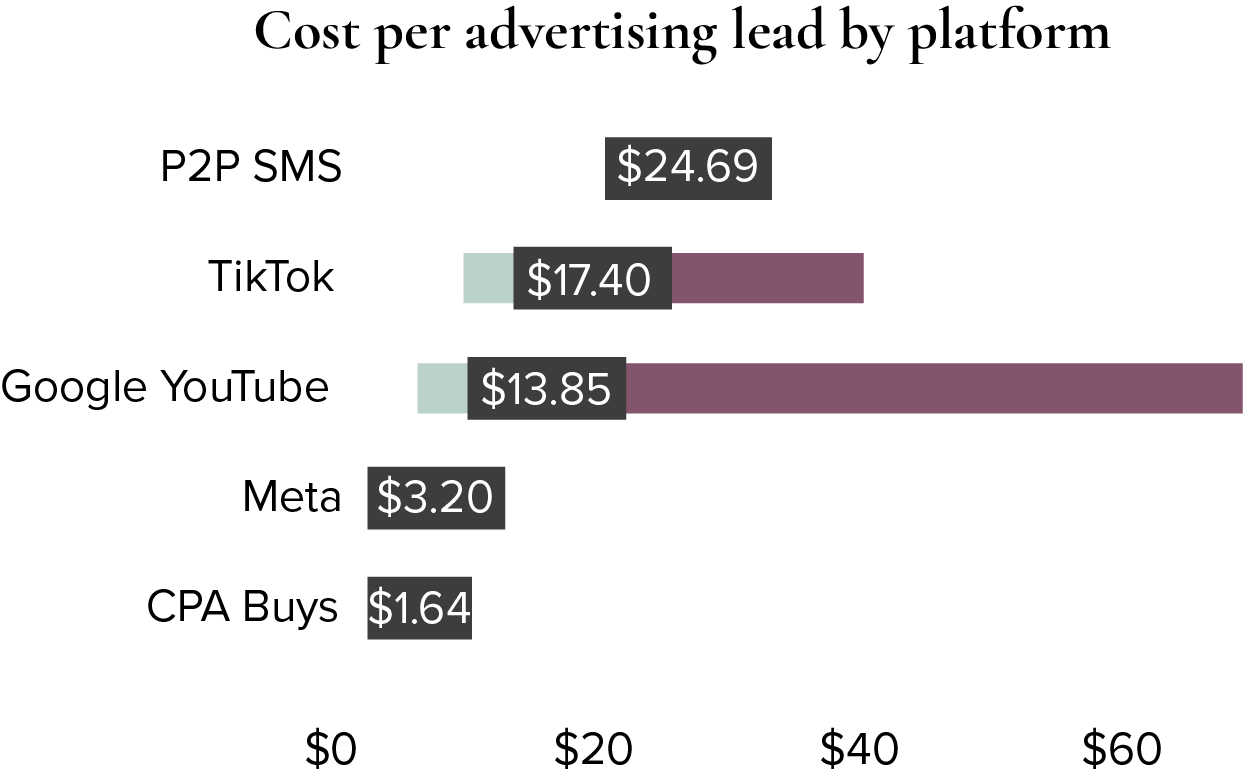
I do see one bright spot, which is the wide range of results on these platforms. Sure, the median cost for a lead on TikTok is $17.40, but many organizations have optimized below that – and many others have vast room to improve. There is so much room to test creative and audiences on these platforms, and it’ll be exciting to see what nonprofits do in that space.
The old world is dying, and the new one struggles to be born
My liberal arts education failed me on that quote — I could’ve sworn it was poetry to match this year’s Benchmarks theme, but a quick google reminded me it was actually the words of Marxist theorist Antonio Gramsci. Tony, forgive me for using your work to talk about the capitalist enterprise that is advertising!
I look at these Benchmarks results and my brain wants to pull together a Big Unifying Thought — a theme that I can take to my work every day and say, here, is this the direction that advertising is going in.
Some years, that big thought is about a particular channel: for example, “social exploded in impact during the pandemic”, or “video has finally arrived.” This year, I look at Benchmarks and wonder, is this the last year we’ll see an ads industry that looks like the one I’m used to?
For years, this industry has been dominated by the Google-Meta duopoly: two tech giants looming over the ads landscape. Today those twin behemoths look weaker than they ever have, as they face a combined threat of rising AI, an increasingly contentious legal environment, and a user base that’s actively seeking alternatives to their products.
We don’t know what will happen next. Maybe Meta and Google will pull through and retain their market dominance! But it’s possible (even likely) that they won’t — and it’s anyone’s guess what happens next.
In this moment of change and uncertainty, I’m encouraged to see so many nonprofits rising to the challenge. Organizations are taking calculated risks (like piloting new channels!) and making long-term investments (like brand ads to improve their positioning when fundraising opportunities arise). That’s exactly what we need to do right now, and I’m honestly just so excited to see where we go next.



